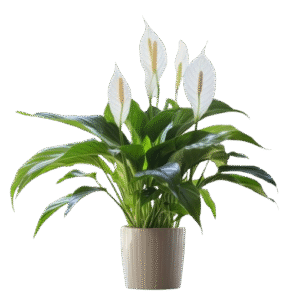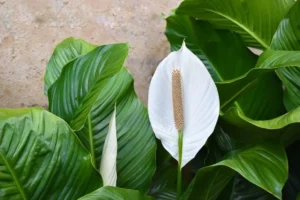
What is the plant ?
he Peace Lily Plant, also called Spathiphyllum wallisii, is a great choice for easy indoor plants, with shiny green leaves and unique white spathes. With simple care needs, the Peace Lily does well indoors.
The Peace Lily Plant has beautiful dark green leaves that spread out elegantly from the plant’s base. In early summer, you can see pretty white spoon-shaped spathes on the plant, holding a cluster of tiny, true flowers. They typically grow to 1-4 feet (30-120 cm) indoors and up to 6 feet (1.8 m) outdoors in 3 years. Remember, they can be harmful to pets and humans, so be careful where you put them in your home.

How to Care for the Plant ?
-
- Water :
Consistently water your S. wallisii, making sure the soil doesn’t get too wet, which can harm the roots. Let the top inch (2.5 cm) of soil dry out before watering, adjusting the frequency based on the pot size and drainage. Water less in winter, but don’t let the soil completely dry out. If your tap water has a lot of chlorine, use filtered or distilled water or let tap water sit for a few days to let the chlorine evaporate.
-
- Pruning :
You don’t need to prune unless you see dead or sick parts that could spread. Pruning can help it grow more, so do it every 6 months or more often if needed.
-
- Fertilizer :
Give the plant a bit of balanced houseplant fertilizer every month with micronutrients at half strength in spring and summer. Watch out for yellow leaf edges, which could mean it needs more magnesium and iron. During summer, consider feeding it every week or using slow-release pellets as instructed, but don’t fertilize in winter.
-
- Propagation :
Keep the Peace Lily Plant at 65-75°F (18-24°C) all year, protecting it from cold drafts and AC vents. It can’t survive for long under 55°F (13°C). To make the best conditions, spray the leaves weekly with softened or distilled water in the summer to make it more humid.
-
- Container :
These flowers like slightly crowded conditions, but when their roots outgrow the pot, it’s time to replant. Use a terracotta or clay container to handle excess water. Get a pot that’s a third bigger than the root ball and not more than 10 inches (25 cm) for healthy growth.

-
- Popularity :
461,153 people already have this plant 37,595 people have added this plant to their wishlists .
